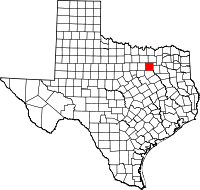Fruitdale, Dallas, Texas
USGenWeb >> TXGenWeb >> Dallas County >> Towns & Communities >> Fruitdale, Texas
 |
|
| Latitude | 324225N 32.7070759 |
| Longitude | 0964609W -96.7691664 |
| Elevation feet/meters |
469/143 |
| Zip Code | |
| Founded | |
| GNIS FID | 1336282 |
| TXGenWeb Site | |
| Cemeteries | |
| Library | |
| Local Genealogy Society | |
| Wikipedia | |
| Fruitdale | |
Fruitdale, sometimes called Fruitdale Acres, is an area in Dallas, Texas, United States that used to be its own incorporated city.
On April 17, 1937 Fruitdale incorporated so it would not be annexed by Dallas. In October 1964 residents voted to disincorporate and Dallas annexed Fruitdale in November of that year.
Fruitdale was three miles south of downtown Dallas in central Dallas
County. The site is now bounded by Fordham Road on the north, the
Missouri, Kansas, and Texas tracks to the east, Ledbetter Drive on
the south, and Sunnyvale Street to the west. It was in the original
land grants of J. K. Sloan and G. L. Haas. Although the first
settlers in the area named it Christian Valley when they arrived in
the 1850s, the real influx occurred after the Civil War. In 1886 the
Missouri, Kansas, and Texas Railway was extended through Fruitdale.
The settlement remained a quiet farming community into the twentieth
century.
On April 17, 1937, Fruitdale incorporated to avoid annexation to Dallas. It had a population of 432 and was sometimes called Fruitdale Acres. The citizens imposed deed restrictions that allowed no businesses within the city limits. After World War II families moved to Fruitdale because of its large lots with space for gardens and yards for children to play in. Former farms were cut up into lots, and most houses were built on at least half an acre. Many families raised food for their own use in orchards or truck gardens. Every home had its own well and septic tank, but gas and electricity were available. The fire station had one full-time employee and twenty-five volunteer firemen, and the town had an elected city marshall for police protection, a stone community house, a church, and a five-acre city park.
.... Read More TSHA ....




